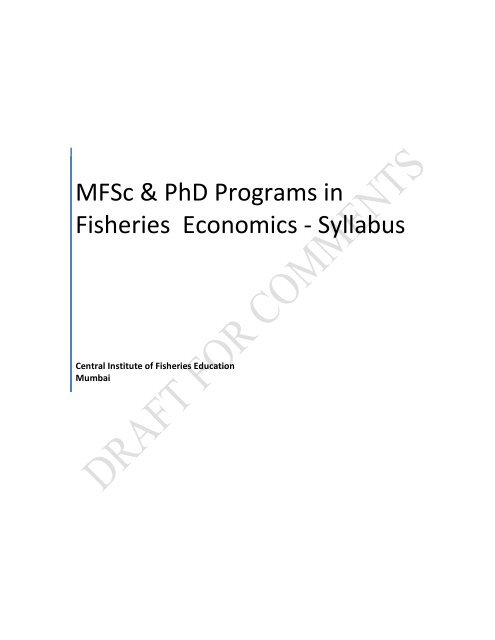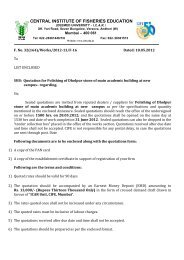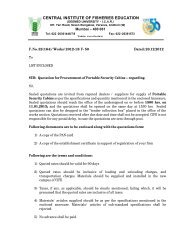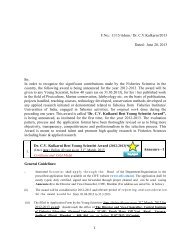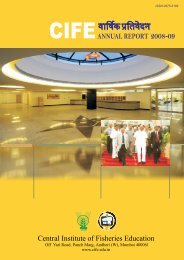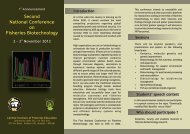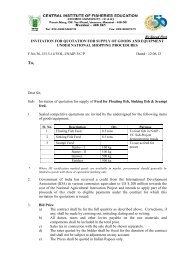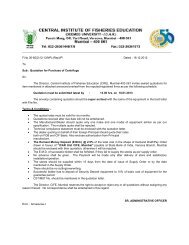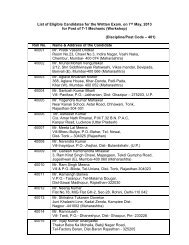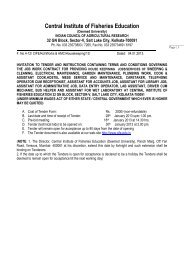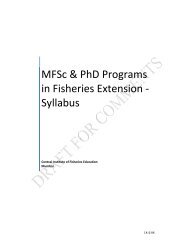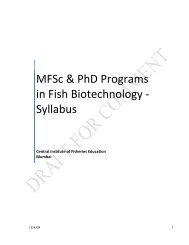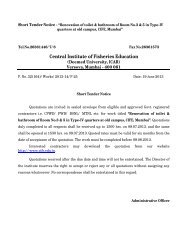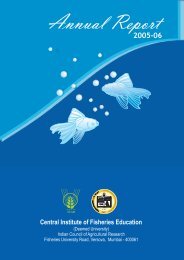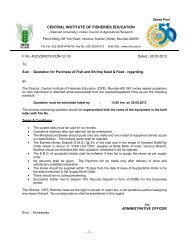Fisheries Economics MFSc & PhD Syllabus.pdf - Central Institute of ...
Fisheries Economics MFSc & PhD Syllabus.pdf - Central Institute of ...
Fisheries Economics MFSc & PhD Syllabus.pdf - Central Institute of ...
You also want an ePaper? Increase the reach of your titles
YUMPU automatically turns print PDFs into web optimized ePapers that Google loves.
<strong>MFSc</strong> & <strong>PhD</strong> Programs in<br />
<strong>Fisheries</strong> <strong>Economics</strong> - <strong>Syllabus</strong><br />
<strong>Central</strong> <strong>Institute</strong> <strong>of</strong> <strong>Fisheries</strong> Education<br />
Mumbai
<strong>MFSc</strong> (<strong>Fisheries</strong> <strong>Economics</strong>) Program Structure and Major Courses<br />
S. No. Course No Titles Credits<br />
Major - Core Courses<br />
1. FEC 501 Microeconomics 2+1<br />
2. FEC 502 Macroeconomics 2+1<br />
3. FEC 503 Marketing Management 2+1<br />
4. FEC 504 <strong>Fisheries</strong> Resource <strong>Economics</strong> 2+1<br />
Major - Optional Courses<br />
5. FEC 505 <strong>Economics</strong> <strong>of</strong> Development and Planning 2+0<br />
6. FEC 506 Finance and Co-operation 1+1<br />
7. FEC 507 Econometrics 1+1<br />
8. FEC 508 Indian Economy 2+0<br />
9. FEC 509 Project Formulation and Management 1+1<br />
10. FEC 510 International <strong>Economics</strong> and Trade I 1+1<br />
11. FEC 511 Price Policy and Analysis 1+1<br />
12. FEC Envronmental <strong>Economics</strong> 2+1<br />
Minor Courses<br />
1. FBM-510 Introduction to WTO and IPR 1+1<br />
2. FBM 513 Forecasting Methods & Operations<br />
1+1<br />
Research<br />
3. FBM 516 Indian and Global <strong>Fisheries</strong> Industry 1+ 1<br />
Supporting Courses<br />
1 FBM 508 Statistical Methods 1+1<br />
2 FBM 509 Research Methodology 1+1<br />
18/4/08 1
<strong>PhD</strong> (<strong>Fisheries</strong> <strong>Economics</strong>) Program Structure and Major Courses<br />
S. No. Course No Titles Credits<br />
Core Courses<br />
1. FEC 601 Advanced Economic Analysis 2+1<br />
2. FEC 602 Advanced Marketing and Price Analysis 2+1<br />
3. FEC 603 Environmental <strong>Economics</strong> 2+1<br />
Optional Courses<br />
1. FEC 604 Advanced Econometrics 1+1<br />
2. FEC 605 <strong>Fisheries</strong> Planning and Policies 2+0<br />
3. FEC 607 Aquaculture Production <strong>Economics</strong> 1+1<br />
4. FEC 608 Marine Resource <strong>Economics</strong> 1+1<br />
5. FEC 609 International <strong>Economics</strong> and trade II 1+1<br />
6. FEC 610 <strong>Fisheries</strong> Governance and Socio <strong>Economics</strong> 1+1<br />
Supporting Courses<br />
1. 1 FEC 621 Advanced Statistical Methods 1+1<br />
2. FEC 613 Research Methodology for Social Sciences 1+1<br />
18/4/08 2
CORE COURSES<br />
FEC 501 Microeconomics (2+1)<br />
Objectives<br />
Theory:<br />
Unit 1<br />
• To familiarize the students with the basic concepts and principles <strong>of</strong> microeconomics<br />
including the analytical tools.<br />
Theory <strong>of</strong> demand, Consumer Behavior, Cardinal Utility, indifference curve theory, revealed<br />
preference theory, consumer surplus.<br />
Unit II<br />
Market demand-derivation, determinants, elasticities, and demand for the product <strong>of</strong> a firm.<br />
Unit III<br />
Theory <strong>of</strong> cost- Traditional, Modern theory, Engineering cost curves, Analysis <strong>of</strong> economies <strong>of</strong><br />
scale.<br />
Unit IV<br />
Theory <strong>of</strong> the firm-Perfect competition-Short run, long run equilibrium, Monopoly, Price<br />
discrimination, Monopolistic competition, Classical Oligopoly, Average Cost Pricing, Limit Pricing,<br />
Unit V<br />
General Equilibrium theory, Welfare <strong>Economics</strong>.<br />
Practicals / Case studies:<br />
Demand - supply relationship. Elasticity - price, income, cross. Factor-product, factor- factor and<br />
product-product relationships. Production costs and their relationship<br />
Suggested Readings<br />
1. Thomas, C. R. and Charles Maurice, S. Managerial <strong>Economics</strong>, Tata Mcgraw – Hill Publishing Co.<br />
Ltd., New Delhi.<br />
2. Dwivedi, D. N., Managerial <strong>Economics</strong>, Vikash Publishing House, New Delhi.<br />
3. Dewett, K. K., Modern Economic Theory, S. Chands Co. Ltd., New Delhi.<br />
4. Samuelson and Nordnaus, <strong>Economics</strong>, Tata Mcgraw, Hill Publishing Co. Ltd., New Delhi.<br />
5. Mankar, V.G., Business <strong>Economics</strong> – Micro Analysis, Himalaya Publishing House, Mumbai.<br />
6. A.Koutsoyiannis , Modern Micro economics The Mc Millan Press limited,UK<br />
7. Ahuja.A.L., Macroeconomics- Theory and Practice S Chand and Company, New Delhi<br />
8. Mankiw Gregory Micro and Macro economics<br />
18/4/08 3
FEC 502 Macroeconomics (2+1)<br />
Objectives<br />
• to familiarize the student with the basic concepts and principles <strong>of</strong> macroeconomics<br />
including the analytical tools used for them<br />
Theory :<br />
Unit I<br />
Macroeconomics-National Income Accounting,<br />
Unit II<br />
Classical Theory <strong>of</strong> income and employment, Keynes theory <strong>of</strong> employment,<br />
Unit III<br />
Consumption function, Theories <strong>of</strong> consumption, Multiplier, Inducement to invest and marginal<br />
efficiency <strong>of</strong> capital,<br />
Unit IV<br />
IS-Lm Curve Model, Aggregate Demand, Aggregate Supply, Unemployment and Full Employment<br />
Unit V<br />
Inflation- nature and causes and control measures ,Business Cycle theory, Money- demand,<br />
Nature and Function <strong>of</strong> money, Credit and Commercial Banking ,<strong>Central</strong> Banking ,<br />
Unit VI<br />
Money Supply and its determinants, Economic stabilizations-Fiscal and Monetary policy, Public<br />
Finance, Public revenue and taxation, Balance <strong>of</strong> Payment, Foreign Exchange<br />
Practical / Case studies :<br />
National income accounting, consumption and investment function, inflation, money supply balance<br />
<strong>of</strong> payment, foreign exchange<br />
Suggested Readings<br />
1. M.L.Ahuja Macro economics,<br />
2. David Colander Macreconomics<br />
3. K.K.Dewett Macroeeconomics S.Chand Publishers<br />
4. Samuelson Nordhaus <strong>Economics</strong><br />
18/4/08 4
FEC 503 Marketing Management (2+1)<br />
Objectives<br />
• to familiarize the student with the basic concepts and principles <strong>of</strong> marketing as applied to<br />
management decisions<br />
• to gain an understanding <strong>of</strong> the different types <strong>of</strong> marketing concepts, including the<br />
analytical tools used for them<br />
• to provide an interface between marketing and management decision<br />
Theory :<br />
Unit I<br />
Marketing management - Introduction and overview.<br />
Marketing system and environment Market opportunity identification- Customer analysis.<br />
Market segmentation, market positioning and consumer behaviour, Competition analysis, Market<br />
assessment, Marketing environment,<br />
Unit II<br />
Demand assessment and forecasting, Designing the <strong>of</strong>fer-product decision and pricing decision,<br />
product decisions and strategies, product life cycle, new product development, branding and<br />
packaging decisions Delivering the <strong>of</strong>fer-distribution management, sales management and<br />
communication strategy an management.<br />
Unit III<br />
Product management. Pricing policies and practices. Distribution strategy - channels <strong>of</strong><br />
distribution, physical distribution..<br />
Unit IV<br />
Marketing information system. Marketing communication - advertising, publicity, personal selling,<br />
sales promotion<br />
Unit V<br />
Marketing research and information system, Marketing research and its application in fisheries<br />
marketing strategy, planning and organisation, emerging issues in marketing, e-marketing<br />
Practical / Case studies :<br />
Marketing mix, marketing strategy, segmentation, pricing methods, consumer behaviours, new<br />
product development, marketing research, measuring effectiveness <strong>of</strong> marking mix, performance<br />
evaluation, efficiency analysis<br />
Suggested Readings<br />
1. Phillip Kotler, Marketing Management, Prentice Hall <strong>of</strong> India Pvt. Ltd., New Delhi.<br />
2. Ian Chaston, Marketing – In <strong>Fisheries</strong> and Aquaculture, Fishing News Books Ltd., England.<br />
3. Dennis Adeock, Ray Brandfield, Al Halhorg and C. Ross, Marketing Principles and Practice,<br />
Pitman Publishing, London.<br />
18/4/08 5
4. Jolson, M. A., Marketing Management, Macmillan Publishing Inc., New Delhi.<br />
5. Amarchand and Varadharajan, B., An introduction to marketing, Vikash Publishing House, New<br />
Delhi<br />
6. Phillip Kotler and Gary Armstrong Principles <strong>of</strong> Marketing. Prentice Hall<br />
FEC 504 <strong>Fisheries</strong> Resource <strong>Economics</strong> (2+1)<br />
Objective:<br />
• To familiarise the students with the concept and application <strong>of</strong> economics to the different<br />
resource based production sytems<br />
Theory:<br />
Unit I<br />
Marine fishery resources <strong>of</strong> India – characteristic features <strong>of</strong> marine capture<br />
fisheries – status <strong>of</strong> marine fisheries in India–<br />
Unit II<br />
Production economics catch and effort studies – methodological issues in the<br />
estimation <strong>of</strong> fish catch and fishing effort – dimensions <strong>of</strong> fishing effort – costs <strong>of</strong> and<br />
returns from fishing – cost components – employment and earnings <strong>of</strong> fishermen in<br />
relation to technological options – production function in marine capture fisheries<br />
Unit III<br />
Population equilibrium analysis – sustainable yield curves – overfishing and<br />
underfishing – open access equilibrium yield – maximum sustainable yield and maximum<br />
social yield – Comparative static models – changes in cost; changes in productivity;<br />
changes in price <strong>of</strong> fish<br />
Management <strong>of</strong> fisheries in an environment <strong>of</strong> risk and uncertainty – challenges<br />
in the management <strong>of</strong> global fisheries – resource management issues – conflict<br />
management – socioeconomic issues and marine policy.<br />
Unit IV<br />
Introduction – aquaculture production process – aquaculture systems in India –<br />
factors affecting the economics <strong>of</strong> aquaculture –<br />
Unit V<br />
Production concepts applied to aquaculture – cost concepts and cost functions –<br />
Returns concepts – least-cost combination <strong>of</strong> inputs – optimization <strong>of</strong> aquaculture<br />
production –<br />
Unit VI<br />
planning and budgeting – lineal programming – economies <strong>of</strong> scale – production<br />
function analysis – management <strong>of</strong> aquaculture production process – aquaculture<br />
management decisions – resource management – labour and personnel management –<br />
financial management – management <strong>of</strong> risk and uncertainty in aquaculture – economics<br />
<strong>of</strong> different aquaculture systems – socioeconomic issues in aquaculture development.<br />
18/4/08 6
Practices/Case Studies:<br />
Design <strong>of</strong> a survey schedule for capture fisheries economics – catch and effort surveys – cost<br />
per fishing trip – unit cost <strong>of</strong> production <strong>of</strong> fish – economics <strong>of</strong> capture fisheries – market surveys –<br />
rate <strong>of</strong> growth <strong>of</strong> exports <strong>of</strong> marine products – case studies <strong>of</strong> fishing, fish processing and marketing<br />
firms<br />
Estimation <strong>of</strong> costs and returns <strong>of</strong> different aquaculture systems – planning and<br />
budgeting – linear programming production function analysis – cost function analysis –<br />
financial and farm business analysis – risk programming – case studies – visit to fish<br />
farms, prawn farms and hatcheries – discussion on socioeconomic issues in aquaculture<br />
development.<br />
Suggested Readings ( Add)<br />
AndersonJ L <strong>Fisheries</strong> resource <strong>Economics</strong> oxford IBH<br />
Shang Y Aquaculture production <strong>Economics</strong><br />
18/4/08 7
Optional Courses<br />
FEC 505 <strong>Economics</strong> <strong>of</strong> Development and Planning (1+1)<br />
Objective:<br />
• to acquaint the students with the concept <strong>of</strong> development and planning<br />
Theory :<br />
Unit I<br />
<strong>Economics</strong> <strong>of</strong> development: concepts and approaches, economic growth and income<br />
distribution, Characteristics <strong>of</strong> an under developed country , Obstacles to economic<br />
development,<br />
Unit II<br />
economic growth, Meaning and characteristics <strong>of</strong> modern economic growth, Adam smith<br />
theory,The Ricardian theory, The Malthusian theory ,,The classical theory, Lewis’s theory <strong>of</strong><br />
unlimited supply <strong>of</strong> labor,The Marxin theory,The Harrod- Domar Model, The Solow Model <strong>of</strong><br />
long run growth, The Mahalanobis Model,<br />
Unit III<br />
Growth models in Indian planning, Capital formation and economic Development, Monetary<br />
policy in economic development, Fiscal policy in Economic development, Price policy in<br />
Economic development, Economic planning , Types <strong>of</strong> planning, Shadow prices, Input-output<br />
analysis,<br />
Unit IV<br />
<strong>Fisheries</strong> development and policy under the plans<br />
Practicals /Case studies :<br />
Physical Quality <strong>of</strong> Life Indices, Human Development index, Shadow prices, Leontieff model <strong>of</strong> Input<br />
Output model , , Analysis <strong>of</strong> the different growth models across the different plan periods<br />
Suggested Readings<br />
1 M.L.Jhingan <strong>Economics</strong> <strong>of</strong> Development and Planning<br />
2. Agarwal Indian economy<br />
3. H .L.Ahuja Indian Economy<br />
‘<br />
.<br />
18/4/08 8
FEC 506 ENVIRONMENTAL ECONOMICS (2+1)<br />
Theory:<br />
Ecology and economics - principles <strong>of</strong> environmental economics - public goods, club goods and<br />
theory <strong>of</strong> common property - property rights and ownership incentives equimarginal principle -<br />
discounting and risk, user cost, existence value - substitution between capital and natural resources<br />
- environmental externalities. Population question and theory <strong>of</strong> demographic transition - poverty,<br />
development and environment –environment and trade - concept and practice <strong>of</strong> sustainability.<br />
Market and non-market valuation <strong>of</strong> natural resources - measurement <strong>of</strong> environmental harm and<br />
benefit - contingent valuation - difficulties in application <strong>of</strong> a supply/demand or benefit/cost<br />
framework - application <strong>of</strong> a cost-effectiveness or cost-minimization framework. Criteria for<br />
evaluating environmental policies – market based / incentive based strategies like emission taxes<br />
and subsidies, transferable discharge permits - polluter pays principle. Kyoto Protocol, carbon<br />
trading, CDM and GEF - environmental policies in major industrialised and industrialising countries -<br />
international environmental agreements<br />
Concept and principles <strong>of</strong> EIA; methodologies for EIA in fisheries and aquaculture sector;<br />
Institutional (International/National/Stale/Local) arrangements and strategies for estimation,<br />
amelioration and compensation for impacts; Aquaculture Authority Bill and AAI. Environment<br />
related conflicts and dispute resolution; Coasian theorem and stakeholder decision making process.<br />
Economic theory <strong>of</strong> fish resource exploitation - absent property rights in fisheries sector - common<br />
property resource use and management - scarcity and competitive exploitation in fisheries sector -<br />
concepts <strong>of</strong> Maximum Sustainable Yield (MSY), M/NEY, OSY, Static and Dynamic MEY, and their<br />
interrelationships.<br />
Practical / Case studies:<br />
Case studies on environmental economics <strong>of</strong> shrimp farming (intensive/ semi-intensive/ extensive)<br />
and polyculture farms - Application <strong>of</strong> Extended Domestic Resource Cost Ratio and Policy Analysis<br />
Matrix for aquaculture - Case studies on the sustainability <strong>of</strong> various capture fishery systems -<br />
<strong>Economics</strong> <strong>of</strong> inland water and marine pollution - economics <strong>of</strong> pollution control - economics <strong>of</strong><br />
climate change, global warming and fisheries development - Gordon-Schaefer growth model,<br />
Dynamic Poll model and Bioeconomic model <strong>of</strong> fisheries resource management.<br />
References:<br />
1. Bhattacharya, Rabindra, 1997. Environmental <strong>Economics</strong>: An Indian Perspective, OUP, New<br />
Delhi.<br />
2. Modak Prasad and Biswas, 2001. Conducting Environmental Impact Assessment for Developing<br />
Countries, OUP, New Delhi.<br />
3. Alistair Ulph, 2000. Environmental Policy, International Agreements and International Trade,<br />
OUP, New Delhi.<br />
4. Madhav Gadgil, 1997. Ecological Journeys: The Science and Politics <strong>of</strong> Conservation in India,<br />
Orient Longman, Hyderabad.<br />
Cunningham S., Dunn M.R. and Whitmarsh, D., 1985. <strong>Fisheries</strong> <strong>Economics</strong> - An Introduction, Mansell<br />
Publishing Ltd., London.<br />
18/4/08 9
FEC 511 PROJECT FORMULATION AND MANAGEMENT (1+1)<br />
Objectives:<br />
• To familiarize the student with the basic concepts and principles <strong>of</strong> project formulation and<br />
management techniques.<br />
• To prepare the students to exploit business opportunities in fisheries and aquaculture.<br />
Theory<br />
Unit I: Concept, scope and definition <strong>of</strong> project - difference between plan and project – project types<br />
- advantages and limitations – elements <strong>of</strong> project cycle - aspects <strong>of</strong> project preparation and<br />
analysis - project cost and benefits – comparisons – tangible and intangible cost and benefits.<br />
Unit II:Financial and economic aspects <strong>of</strong> projects: feasibility analysis – undiscounted measures <strong>of</strong><br />
project worth - ranking by inspection, pay back period, average annual proceeds per unit <strong>of</strong> outlay -<br />
time value <strong>of</strong> money - discounted measures – discounted pay back period, derivation <strong>of</strong><br />
incremental net benefit, net present worth, BC ratio, IRR, net benefit investment ratio, project<br />
alternatives - risk and uncertainties - sensitivity analysis.Farm planning, budgeting – complete and<br />
partial budgeting - farm business analysis and appraisal techniques – ratio analysis, asset valuation<br />
and depreciation. Financial analysis-balance sheet, cash flow analysis, pr<strong>of</strong>it loss statements.<br />
Unit III: Guidelines for project preparation report – objective, rational, area, organization,<br />
production, markets and financial results, benefits. Sources <strong>of</strong> institutional assistance for project<br />
preparation and formulation – bilateral and multilateral assistance. Project implementation –<br />
objective and tasks, economic aspects <strong>of</strong> project evaluation. Project management – management<br />
technique – bar chart, milestone chart, activity slack bar chart, PERT, CPM, inventory management<br />
and control, management information system and project monitoring.<br />
Practicals/Case studies:<br />
Practical and Case studies: Ratio analysis, computing depreciation, valuation <strong>of</strong> project inventories,<br />
complete and partial Budgeting, cash flow analysis, balance sheet / net worth statement, pr<strong>of</strong>it–loss<br />
statement/income statement–undiscounted and discounted measures – net work techniques - bar<br />
charts, milestone chart and activity slack bar chart, PERT and CPM - project preparation for capture,<br />
culture and processing sectors - sensitivity analysis - project monitoring and evaluation – case<br />
studies and feasibility evaluation.<br />
Suggested Readings:<br />
1. Shyam S Salim, Biradar, R.S. and Pandey, S.K., Economic Analysis <strong>of</strong> <strong>Fisheries</strong> Projects, CIFE,<br />
Mumbai.<br />
2. Ojha, S.N. and Shyam S Salim, Entrepreneurship Development and Project Formulation, CIFE,<br />
Mumbai<br />
3. FAO Technical Paper No.334, <strong>Fisheries</strong> Project Formulation, FAO, Roam.<br />
4. Shang, Y.C., Aquaculture Economic Analysis – An Introduction, The World <strong>of</strong> Aquaculture<br />
Society Ltd.<br />
5. Twiner and Simister (ed.), Project Management, Infinity Books, New Delhi.<br />
6. Chodhury, Project Management Tata McGraw Hill Publishing Company Ltd., New Delhi<br />
Journals<br />
Broad Areas for Research<br />
18/4/08 10
FEC 515 INTERNATIONAL ECONOMICS AND TRADE I (1+1)<br />
Objective:<br />
• To familiarize the student with the basic concepts and principles <strong>of</strong> economics as applied to<br />
international trade<br />
Theory:<br />
Unit I: International trade: nature <strong>of</strong> international trade, difference between domestic and<br />
foreign trade; Theories <strong>of</strong> international trade: absolute and comparative advantage, modern<br />
theories <strong>of</strong> international trade - Hecksher Ohlin theorem;<br />
Unit II: Concepts <strong>of</strong> terms <strong>of</strong> trade, free trade, protection, tariffs, quantitative restrictions and<br />
other non-tariff measures.<br />
Unit III: Exchange rate, devaluation and depreciation, balance <strong>of</strong> payments, international capital<br />
movements, state trading.<br />
Unit IV: International gold standard; International Monetary Fund and World Bank; Multi<br />
National Corporations and international trade; India’s foreign trade and balance <strong>of</strong> payment<br />
Practicals /Case studies:<br />
Pattern and Performance <strong>of</strong> India's Seafood Exports; Case studies on product and market<br />
diversification. Case studies on competitiveness <strong>of</strong> Indian fish and fish products. Case studies<br />
onexports <strong>of</strong> value added seafood products; Case study <strong>of</strong> a seafood export firm;<br />
Case studies on (ab)use <strong>of</strong> SPS / TBT measure; Case studies on non-tariff barriers in fisheries<br />
trade; Case studies on dumping and anti-dumping measures in seafood trade; SWOT analysis <strong>of</strong><br />
WTO; Case Studies on disputes in TRIPS.<br />
Suggested Readings:<br />
1. Dennis Appleyard, Trade Theory and Practice Irwin Publishers<br />
2. Mithani.J.P International <strong>Economics</strong> Tata Mcgraw, Hill, New Delhi<br />
3. Cherunilam Francis International <strong>Economics</strong> Tata Mcgraw, Hill, New Delhi<br />
4. Samuelson and Nordnaus, <strong>Economics</strong>, Tata Mcgraw, Hill, New Delhi<br />
Journals<br />
1. Indian Journal <strong>of</strong> Foreign Trade<br />
2. Economic and Political Weekly<br />
Broad Areas <strong>of</strong> Research<br />
1. Export performance and potential <strong>of</strong> fish and fish products.<br />
2. Economic impact <strong>of</strong> NTBs.<br />
18/4/08 11
FEC 521 FISHERIES FINANCING AND COOPERATION (1+1)<br />
Theory:<br />
Unit I: Finance and investment in Indian <strong>Fisheries</strong>; Investment by private sector, public sector<br />
and cooperative sector; financial requirement in capture and culture fisheries, Types <strong>of</strong> fisheries<br />
finance, Institutional finance for capture and culture fisheries, NABARD, commercial banks,<br />
RRBS, NCDC, IDBI, Land Development Banks, External financing in fisheries; WB, IMF DANIDA,<br />
NORAD, financing systems in fishery industry <strong>of</strong> selected countries such as Japan, Norway, UK,<br />
and USA etc.<br />
Unit 11: <strong>Fisheries</strong> Cooperatives: Principles and scope <strong>of</strong> cooperative review <strong>of</strong> fisheries<br />
cooperative in important country, development <strong>of</strong> fisheries cooperative in India, Structure and<br />
functions <strong>of</strong> fisheries cooperative; Evaluation <strong>of</strong> the performance fisheries cooperatives.<br />
Managerial aspects <strong>of</strong> cooperative societies; cooperative marketing in fisheries, State fisheries<br />
cooperative Federations, <strong>Fisheries</strong> Corporation, Self Help Groups in fisheries.<br />
Practical / Case studies:<br />
Different case studies on fisheries cooperative societies and their performance (marine and<br />
inland sector).<br />
Suggested Readings:<br />
1. FAO, 1971. Manual on Fishermen’s Co-operatives, Rome.<br />
2. B.S.Bhatia, H.L.Verma, Mahesh. C. Harg., 2001. Encyclopaedia <strong>of</strong> Co-operative Management<br />
(Vol. I, II, III, IV), Deep and Deep publications, New Delhi<br />
3. R. Rajagopalan, 1997. Rediscovering cooperation Vol. I, II, III, IRMA Anand.<br />
4. Ronald W. Cotterill, 1998. Competitive Strategy Analysis for Agri-marketing Co-operatives.<br />
5. FISHCOPFED, 1989. Fish Co-operatives, New Delhi<br />
Journals<br />
1. Co-operator<br />
2. Journal <strong>of</strong> Co-operative Management<br />
Broad Areas <strong>of</strong> Research<br />
18/4/08 12
FEC 507 Introductions to Econometrics (1+1)<br />
• to familiarize the student with the fundamental principles <strong>of</strong> econometrics<br />
• to apply the theoretical knowledge in econometrics to analysing empirical phenomenon<br />
Theory:<br />
Unit I<br />
Econometrics Introduction relationship with other disciplines Matrix algebra,<br />
Unit II<br />
Assumptions in the classical linear regression model;<br />
Consequences <strong>of</strong> multicollinearity, heteroscedasticity, autocorrelation and remedial measures;<br />
Unit III<br />
Econometric model specification criteria, specification errors, measurement errors <strong>of</strong> dependent<br />
and explanatory variables, Different model specification criteria;<br />
Unit IV<br />
Time series econometric models, Basic ideas in fitting non-linear regression models.<br />
Practical / Case studies:<br />
Exercises on fitting classical linear regression models, detection <strong>of</strong> multicollinearity,<br />
heteroscedasticity and autocorrelation in the given data sets, Model selection using R 2 , AIC and<br />
SIC criteria.<br />
Suggested Readings<br />
1. Damodhar Gujarati, 2004. Basic Econometrics, McGraw-Hill, New Delhi.<br />
2. Stewart, J. and Gill, L., 1998. Econometrics, Prentice Hall, New Delhi.<br />
3. Thomas, R.L., 1985. Introductory Econometrics: Theory and Applications, Longman, UK.<br />
4. Eniya, T., 1985. Advanced Econometrics, Basil Blackwell, London.<br />
5. Maddala, G.S., 1977. Econometrics, McGraw Hill, New Delhi.<br />
18/4/08 13
FEC 508 Indian Economy (2+0)<br />
Objectives:<br />
• To acquaint the students with the different facets <strong>of</strong> the Indian economy<br />
Theory:<br />
Unit I<br />
Underdevelopment and the Indian economy ,National income <strong>of</strong> India ,Human resources and<br />
economic development,<br />
Unit II<br />
Human development in India, Occupational structure and economic development, Planning and<br />
Economic development ,Objectives and strategy <strong>of</strong> economic planning ,Industrial policy and<br />
Indian planning<br />
Unit III<br />
,Public sector and Indian planning ,Disinvestment <strong>of</strong> public enterprises ,Private sector , joint<br />
sector and Indian planning ,privatization and economic reform, ,<br />
Unit IV<br />
security in India ,Foreign trade <strong>of</strong> India, India’s balance <strong>of</strong> payment , Indian currency system ,<br />
Indian financial system, the problem <strong>of</strong> capital formation, Indian public finance ,Government<br />
subsidies in India<br />
Suggested Readings<br />
Rudaar Dudtt and Sundaram Indian Economy S.Chand publishers 2007<br />
<strong>PhD</strong> <strong>Syllabus</strong><br />
CORE COURSES<br />
FEC 601 Advanced economic Analysis (2+1)<br />
Objectives<br />
• To develop an analytical framework to understand the inter-linkages among the<br />
crucial microeconomics and macroeconomics variables and various segments <strong>of</strong> an<br />
economy<br />
• To provide an interface between tools and its application in the economy<br />
Unit-I<br />
Theory <strong>of</strong> consumer behaviour: concepts, analytical approaches, limitations and applications,<br />
demand theory, demand functions-derivations analytical approaches, limitations and applications<br />
and elasticity decomposition analysis, Recent developments in the theory <strong>of</strong> demand – linear<br />
expenditure system, constant elasticity demand function, dynamic versions <strong>of</strong> demand functions<br />
18/4/08 14
distributed lag models, Houthakker’s and Taylor’s dynamic models; utility functions - separable and<br />
additive, homogenous and homothetic functions, direct and indirect.<br />
Unit-II<br />
Basic theory <strong>of</strong> the firm: concepts, production functions, isoquants derivations and applications,<br />
optimization behaviour – alternative models, short run and long run cost functions; total price<br />
effect-substitution effect, output effect and pr<strong>of</strong>it maximization effect decomposition analysisanalytical<br />
approaches, joint products-concepts and constrained optimization.<br />
Unit III<br />
Extended theory <strong>of</strong> the firm: homogenous production functions; constant elasticity <strong>of</strong> substitution<br />
production functions-concepts, properties, equilibrium analysis and applications; duality in<br />
production, production under uncertainty, linear production functions for single and multi output<br />
cases.<br />
Unit IV<br />
Commodity market equilibrium-short run, long run, differential cost conditions; theory <strong>of</strong> cost and<br />
empirical evidence on the shape <strong>of</strong> cost functions, taxation applications,<br />
Theory welfare: - Criteria <strong>of</strong> social welfare, Determination <strong>of</strong> welfare maximizing out put-mix,<br />
Commodity Distribution and Resources Allocation<br />
Unit V<br />
Concept and measurement: national income, Consumption, Investment Function and Multiplier<br />
Price level, inflation, CPI, WSPI, in the economy. The concept <strong>of</strong> full employment, inflationary gap.<br />
The theory <strong>of</strong> income determination and multiple market economic systems, Multiplier and<br />
accelerator analysis, Monetary and fiscal policies, Taxes & Expenditure,<br />
Practical / Case studies :<br />
Demand function and it’s derivation, computation <strong>of</strong> demand and supply elasticity, Derivation <strong>of</strong><br />
cost function, Measurement <strong>of</strong> National income Accounts Multiplier Price level, inflation, CPI, WSPI,<br />
Suggested Readings:-<br />
1) Henderson, J. M. and R. E. Quandt. (1972): Micro Economic Theory; A Mathematical Approach.<br />
McGraw Hill, Kogakusha Ltd.<br />
2) Koutsoyiannis, A. (1979): Modern Microeconomics, Macmillan Press Ltd., ELBS, London.<br />
3) Ferguson, C.E. (1989): Micro Economic Theory. AITBS, New Delhi.<br />
4) Mansfield, Edwin (1989): Applied Micro <strong>Economics</strong>, WWW Norton, New York.<br />
5) Leftwich, Richard H. and D. R. Eckert. (1962): The Price System and Resource Allocation. The<br />
Dryden Press, Halt Saunders, Japan.<br />
6) Ackley, Gardner (1963). Macroeconomics: Theory and Policies. Macmillan, New York.<br />
7) 2. Dernburg, T. F. (1985). Macroeconomics: Concepts, Theories and Policies. McGraw Hill,<br />
Singapore.<br />
8) Skaggs, N.T and Carlson, J.L. (1996). Macroeconomics. Blackwell, Oxford.<br />
9) Shapiro, E.J. (1989). Macroeconomic Analysis. Harcourt Brace Jovanovich, New York.<br />
10) Branson H.William (1977) Macroeconomics Theory and Policy :London Harper&Row publishers<br />
18/4/08 15
FEC 602 Advanced Marketing and Price Analysis (2+1)<br />
Objectives<br />
• To familiarize the student with the basic concepts and principles <strong>of</strong> marketing as applied to<br />
management decisions<br />
• To provide an interface between marketing and management decision<br />
Theory:<br />
Unit-I<br />
<strong>Fisheries</strong> Marketing definition and scope, functions <strong>of</strong> fish marketing, Markets and market structure,<br />
Government and Co-operative in fisheries marketing , integration, marketing efficiency, marketing<br />
cost and price spread, marketing planning, marketing strategy, marketing research, Marketing<br />
infrastructure, Marketing regulations, constraints and approaches to fish marketing development.<br />
Unit-II<br />
Supply Chain Management Concepts and Evolution, value addition in fish marketing. Constraints<br />
and approaches to SCM in fisheries sector. Vertical integration and its effect on price determination.<br />
Domestic and external markets for fisheries products. Indian fisheries intervention,<br />
Unit-III<br />
Developing marketing strategies. Advanced studies <strong>of</strong> marketing information system and e-<br />
marketing, fish-business. Dynamics and innovations in fisheries marketing system. Applications <strong>of</strong><br />
econometric methods <strong>of</strong> analysis for the study <strong>of</strong> market behaviours. Computer application in<br />
marketing management:Market intelligence, its need, analysis anddissemination<br />
Unit-IV<br />
Principles <strong>of</strong> price determination. Price difference and variability, price analysis, price elasticities,<br />
Price determination <strong>of</strong> fish and fishery products, characteristics <strong>of</strong> demand and supply <strong>of</strong> fish and<br />
fishery product , supply responses, seasonality, future trading, price support measures. Price<br />
stabilisation policies<br />
Unit-V<br />
Seafood and Aquaculture Markets World-wide, Marketing Channels, Economies <strong>of</strong> Scale, <strong>Economics</strong><br />
<strong>of</strong> Processing, Economic Feasibility and Business Plan Development. Policies and Regulations that<br />
Affect Aquaculture Marketing, and Distribution. Indian Seafood and Aquaculture marketing<br />
Environment.<br />
Practical / Case studies<br />
Practical: Price determination <strong>of</strong> <strong>of</strong> fish and fishery products, Price difference and variability, price<br />
analysis, price elasticity’s, Price determination, Market integration and marketing efficiency, Case<br />
studies <strong>of</strong> supply chains in urban and rural fish markets, and exported product and domestically<br />
traded product Country Risk Analysis: case studies <strong>of</strong> comparative risk positions <strong>of</strong> various countries<br />
as export markets for fish products Export Composition and destination <strong>of</strong> Indian agricultural<br />
commodities and seafood products. Import composition and Origin. Analysing Trade performance<br />
before and after WTO; Analysis <strong>of</strong> International price trends and volatility; Case studies <strong>of</strong> seafood<br />
export firms. Case studies <strong>of</strong> economics <strong>of</strong> shrimp farms (intensive/ semi-intensive/ extensive) and<br />
polyculture farms. Extended Domestic Cost Resource Ratio and Policy Analysis matrix for Shrimp<br />
18/4/08 16
farming. Case studies e-marketing dynamics and innovations in fisheries marketing<br />
Suggested Readings:-<br />
5. Phillip Kotler, Marketing Management, Prentice Hall <strong>of</strong> India Pvt. Ltd., New Delhi.<br />
6. Robert E Branson and Norvel, Introduction to Agricultural Marketing, Mc Graw Hill<br />
7. Ian Chaston, Marketing – In <strong>Fisheries</strong> and Aquaculture, Fishing News Books Ltd., England.<br />
8. Dennis Adeock, Ray Brandfield, Al Halhorg and C. Ross, Marketing Principles and Practice,<br />
Pitman Publishing, London.<br />
9. Jolson, M. A., Marketing Management, Macmillan Publishing Inc., New Delhi.<br />
10. Amarchand and Varadharajan, B., An introduction to marketing, Vikash Publishing House, New<br />
Delhi<br />
11. Phillip Kotler and Gary Armstrong Principles <strong>of</strong> Marketing. Prentice Hall<br />
12. G. E. Shephard. Agricultural Price Analysis. Iowa State University Press, Ames, Iowa<br />
13. Hamdy, A. Taha (1999). Operations Research: An Introduction. Prentice Hall, New Delhi<br />
FEC 603 Environmental <strong>Economics</strong> 2+1<br />
Objectives<br />
• To familiarize the students with the basic concepts and principles tools <strong>of</strong> Environmental<br />
<strong>Economics</strong><br />
Theory:<br />
Unit-I<br />
Ecology and economics - principles <strong>of</strong> environmental economics - public goods, club goods and<br />
theory <strong>of</strong> common property - property rights and ownership incentives equimarginal principle -<br />
discounting and risk, user cost, existence value - substitution between capital and natural resources<br />
- environmental externalities.<br />
Unit-II<br />
Population question and theory <strong>of</strong> demographic transition - poverty, development and environment<br />
–environment and trade - concept and practice <strong>of</strong> sustainability. Nature and ipact <strong>of</strong> assets created<br />
under NRGEA on environment and beneficiaries.<br />
Unit-II<br />
Market and non-market valuation <strong>of</strong> natural resources - measurement <strong>of</strong> environmental harm and<br />
benefit - contingent valuation - difficulties in application <strong>of</strong> a supply/demand or benefit/cost<br />
framework - application <strong>of</strong> a cost-effectiveness or cost-minimization framework.<br />
Unit-III<br />
evaluation environmental policies – market based / incentive based strategies like emission taxes<br />
and subsidies, transferable discharge permits - polluter pays principle. Kyoto Protocol, carbon<br />
trading, CDM and GEF - environmental policies in major industrialised and industrialising countries -<br />
international environmental agreements<br />
Unit-IV<br />
Concept and principles <strong>of</strong> EIA; methodologies for EIA in fisheries and aquaculture sector;<br />
Institutional (International/National/Stale/Local) arrangements and strategies for estimation,<br />
18/4/08 17
amelioration and compensation for impacts; Aquaculture Authority Bill and AAI. Environment<br />
related conflicts and dispute resolution; Coasian theorem and stakeholder decision making process.<br />
Unit-V<br />
Economic theory <strong>of</strong> fish resource exploitation - absent property rights in fisheries sector - common<br />
property resource use and management - scarcity and competitive exploitation in fisheries sector -<br />
concepts <strong>of</strong> Maximum Sustainable Yield (MSY), M/NEY, OSY, Static and Dynamic MEY, and their<br />
interrelationships.<br />
Practical / Case studies:<br />
Case studies on environmental economics <strong>of</strong> shrimp farming (intensive/ semi-intensive/ extensive)<br />
and polyculture farms - Application <strong>of</strong> Extended Domestic Resource Cost Ratio and Policy Analysis<br />
Matrix for aquaculture - Case studies on the sustainability <strong>of</strong> various capture fishery systems -<br />
<strong>Economics</strong> <strong>of</strong> inland water and marine pollution - Estimation <strong>of</strong> economic losses <strong>of</strong> environmental<br />
degradation. Environmental costs <strong>of</strong> technological development.- Gordon-Schaefer growth model,<br />
Dynamic Poll model and Bioeconomic model <strong>of</strong> fisheries resource management.<br />
Suggested Readings:-<br />
5. Bhattacharya, Rabindra, 1997. Environmental <strong>Economics</strong>: An Indian Perspective, OUP, New<br />
Delhi.<br />
6. Modak Prasad and Biswas, 2001. Conducting Environmental Impact Assessment for Developing<br />
Countries, OUP, New Delhi.<br />
7. Alistair Ulph, 2000. Environmental Policy, International Agreements and International Trade,<br />
OUP, New Delhi.<br />
8. Madhav Gadgil, 1997. Ecological Journeys: The Science and Politics <strong>of</strong> Conservation in India,<br />
Orient Longman, Hyderabad.<br />
9. Cunningham S., Dunn M.R. and Whitmarsh, D., 1985. <strong>Fisheries</strong> <strong>Economics</strong> - An Introduction,<br />
Mansell Publishing Ltd., London.<br />
10. Randall Alan (1987), Resource <strong>Economics</strong>: An Economic Analysis Approach to Natural<br />
Resource& Environmental Policy, John Wiley, New York.<br />
11. Kerr, John M., et al. (1997). Natural Resource <strong>Economics</strong>: Theory and Applications in<br />
India,Oxford & U3H, New Delhi<br />
12. Tisdell C. (1993), Environmental <strong>Economics</strong>: Policies for Environmental Management &<br />
Sustainable Development, Edward Elgar Pub. Ltd., USA.<br />
18/4/08 18
FEC 604 Advanced Econometrics 1+1<br />
Optional Courses<br />
Objectives<br />
• To familiarize the student with the basic Tools and techniques as applied to economic<br />
decisions<br />
• To provide an interface between applied Econometrics and decision<br />
Theory:<br />
Unit-I<br />
<strong>Economics</strong>, Statistics and Econometrics. Representation <strong>of</strong> economic phenomenon, relationship<br />
among economic variables, linear and non-linear economic models. Regression and Correlation;<br />
Partial correlation; The normality assumption (Classical Normal Linear regression Model Nature <strong>of</strong><br />
Regression Analysis – Simple regression, multiple regression and their assumptions;<br />
Unit-II<br />
Basic concepts <strong>of</strong> matrix algebra, differentiation, integration and probability distribution theory;<br />
Correlation matrix, residual variance, co-efficient <strong>of</strong> multiple correlation, standard errors <strong>of</strong> coefficient<br />
estimates and their uses in regression, analysis <strong>of</strong> partial correlation and its uses in<br />
interpreting regression co-efficients.<br />
Unit-III<br />
Hypothesis testing, Estimation inference; Ordinary least squares – deriving normal equations,<br />
assumptions and properties <strong>of</strong> OLS; Estimation and interpretation coefficients; Large sample<br />
properties – Maximum Likelihood Estimation; Violation <strong>of</strong> basic assumption <strong>of</strong> OLS and remedies<br />
Unit-IV<br />
Multicollinearity, Heteroscedasticity, Autocorrelation, Normality assumption; Use <strong>of</strong> Dummy<br />
Variables – Simultaneous equation model; Time Series Analysis; Basic Econometric Modelling.<br />
Practices/Case Studies:<br />
Application <strong>of</strong> OLS; application <strong>of</strong> generalised least square; Tests for Multicollinearity,<br />
Heteroscedasticity, Autocorrelation, and Normality assumption. Estimation <strong>of</strong> Economic<br />
Parameters.<br />
Suggested Readings:-<br />
1. Anthony, R.N. and Reece, J.S., Accounting Principles, AITBS Publishers and distributors.<br />
2. Maheshwari, S.N. and Maheshwari, S.K., Accountancy, Vikash Publishing House, Delhi.<br />
3. Xavier, G.F., Business Accounting and Financial Analysis, Macmillan Business book<br />
4. Chandra, P., Fundamentals <strong>of</strong> Financial Management, Tata Mcgraw.<br />
5. Frank Wood and Alan Sangster Business Accounting Prentice hall<br />
FEC 605 <strong>Fisheries</strong> Planning and policies 2+0<br />
Objectives<br />
• To familiarize the student with the planning and policies tools and techniques<br />
Theory:<br />
18/4/08 19
Unit-I<br />
Planning in India-Objectives, allocation, achievements and bottlenecks <strong>of</strong> Indian plans, Strategy <strong>of</strong><br />
Indian planning, resource Mobilization,<br />
Unit-II<br />
<strong>Fisheries</strong> Development and policy under the plans, <strong>Fisheries</strong> schemes; <strong>Central</strong>ly and State sponsored<br />
schemes. Different sectoral schemes, Agriculture policies, Need for a separate fishery policy. Leasing<br />
policies for inland water bodes and brackish water bodies in different states, Input Policy, ,<br />
Financing and Credit Policy. fish marketing and pricing policy, Export –Import Policy<br />
Unit-III<br />
Types <strong>of</strong> planning, Stages in the planning process, Planning models. Planning for utilization <strong>of</strong><br />
surplus resources including manpower<br />
Unit-IV<br />
Subsidies in <strong>Fisheries</strong>, regional disparities, poverty and unemployment in India with respect to the<br />
fisherfolk. Policies:, Sectoral study <strong>of</strong> capture and culture fisheries,<br />
Suggested Readings<br />
1. Higgins, Benjamin. Economic Development, Problems Principles and Policies. Universal Book<br />
Stall, New Delhi.<br />
2. Kindleberger, Charles P. Economic Development. McGraw-Hill, New Delhi.<br />
3. Todaro, Machael P. Economic Development in the Third World. Orient Longman, New<br />
Delhi.<br />
4. Meier, Gerald M. Leading Issue in Economic Development. Oxford University Press, Delhi.<br />
FEC- 607 Aquaculture Production <strong>Economics</strong> 1+1<br />
Objectives:<br />
• to familiarize the student with the basic concepts and principles <strong>of</strong> economics as applied to<br />
aquaculture<br />
• to gain an understanding <strong>of</strong> the different types <strong>of</strong> economics concepts the analytical tools<br />
used for them<br />
Theory:<br />
Unit-I<br />
Production economics- nature and scope, approaches terms and concepts Different production<br />
relationship – factor- product, factor - factor, product-product Farm Management. Risk and<br />
Uncertainty, Productions and Cost Concept,<br />
Unit-II<br />
Mathematical analysis <strong>of</strong> production relationship – concept <strong>of</strong> production function, different types,<br />
characteristics, <strong>Economics</strong> Implications, Economic optimum and Physical Optimum, Decision make<br />
with multiple variables,<br />
Unit-III<br />
Decision making with no risk, with risk, Technology, Input use and factor share, Farm business<br />
analysis Economic efficiency in fish production, Yield gap, Yield penalties and Yield declines,<br />
Unit-IV<br />
Economic aspects <strong>of</strong> different aquaculture production systems in India and abroad.<br />
18/4/08 20
Practices/Case Studies:<br />
Estimation <strong>of</strong> the different production relationships, Farm business analysis, Mathematical analysis<br />
<strong>of</strong> production relationship, Estimation <strong>of</strong> physical and economic optimum, Inclusion <strong>of</strong> risk and<br />
uncertainty in aquaculture systems, Incorporation <strong>of</strong> technology as a component in the production<br />
function, Estimation <strong>of</strong> yield gap and factor shares<br />
Suggested Readings<br />
1. Heady, E.O. and Dillon, J.L. (1961) : Agricultural<br />
Production Functions, Kalyani Publishers,New<br />
Delhi.<br />
2. Heady, E.O.: <strong>Economics</strong> <strong>of</strong> Agricultural Production and Resource Use, Prentice Hall, Inc., New<br />
York<br />
3. Gujarati, D.N.(1995): Basic Econometrics, McGraw Hill, Singapore.<br />
4. Sankhayan, P.L. year: Introduction to the <strong>Economics</strong> and Agricultural Production, Prentice<br />
Hall, New Delhi<br />
5. Shyam S Salim,., Biradar, R.S. and Pandey, S.K., <strong>Fisheries</strong> <strong>Economics</strong> and Marketing: An<br />
Introduction, CIFE, Mumbai<br />
6. Lawson, R.M., <strong>Economics</strong> <strong>of</strong> <strong>Fisheries</strong> Development, Frances Pinter (Pub.), London.<br />
7. Shang, Y.C., Aquaculture Economic Analysis – An Introduction, The World <strong>of</strong> Aquaculture<br />
Society Ltd<br />
8. Cunningham, S., Dunn, M.R. and Whitmarsh, D., <strong>Fisheries</strong> <strong>Economics</strong> – An Introduction,<br />
Mansell Publishing Ltd., London.<br />
FEC -608 Marine Resource <strong>Economics</strong> 1+1<br />
Objectives:<br />
• to familiarize the student with the basic concepts and principles <strong>of</strong> economics as applied to<br />
marine resouses<br />
• to gain an understanding <strong>of</strong> the different types <strong>of</strong> economics concepts the analytical tools<br />
used for them<br />
Unit-I<br />
Historical background and characteristics <strong>of</strong> different forms <strong>of</strong> production functions, derivatives,<br />
alternative algebric forms <strong>of</strong> production functions and their applications, choice and functions in<br />
empirical analysis, .<br />
Unit-II<br />
Optimisation and resource allocation. Multiple product relationships. Production possibility curves.<br />
Choice between products and resource use. Spatial and temporal allocation <strong>of</strong> resources. Resourceuse<br />
efficiency: size, productivity and returns to scale,measurement <strong>of</strong> production efficiency.<br />
Unit-III<br />
Problem formulation for programming, preparation <strong>of</strong> input-output matrix, objective functions and<br />
constraint equations. Assumptions <strong>of</strong> L.P. Basic and non-basic solutions; feasible and infeasible<br />
solutions. Simplex method and its application for solving fisheries problems, use <strong>of</strong> artificial factors,<br />
problems <strong>of</strong> degeneracy, inconsistency, infeasible and unbounded solutions. The generalised<br />
18/4/08 21
simplex method; the dual method; the dual simplex method.<br />
Unit-IV<br />
Measurement <strong>of</strong> risk and optimization under risk<br />
Practices/Case Studies: Application <strong>of</strong> linear programming for solving practical problems in farming<br />
with the help <strong>of</strong> following: Variable resource programming, Variable price programming, Integer<br />
Programming, Recursive programming. Theory <strong>of</strong> games and application <strong>of</strong> linear programming for<br />
solving game problems in farm decision making. Transport models, Dynamic programming.<br />
Suggested Readings<br />
1. Heady, E.O. and Dillon, J.L. (1961) : Agricultural Production Functions, Kalyani Publishers,<br />
New Delhi.<br />
2. Heady, E.O.: <strong>Economics</strong> <strong>of</strong> Agricultural Production and Resource Use, Prentice Hall, Inc.,<br />
NewYork<br />
3. Gujarati, D.N.(1995): Basic Econometrics, McGraw Hill, Singapore.<br />
4. Sankhayan, P.L. year: Introduction to the Econo<br />
FEC-609 International <strong>Economics</strong> and trade II 1+1<br />
Objectives<br />
• To gain conceptual clarity the important linkages between domestic economy and its<br />
external sector<br />
• To incorporate international issues in designing strategies changing environment.<br />
Theory:<br />
Unit-I<br />
Concept and Theories <strong>of</strong> international trade – Classical theories, Reciprocal demand, Offer curve<br />
technique; concepts <strong>of</strong> terms <strong>of</strong> trade, gains from trade, international trade as a substitute for<br />
growth, theory <strong>of</strong> immesirising growth; Modern theory <strong>of</strong> international trade – Hecksher-Ohlin<br />
theory, factor price equalization theory, Stopler Samuelson theory, Robynsky theorem, recent<br />
theories <strong>of</strong> international trade.<br />
Unit-II<br />
Developing Countries' Concerns <strong>of</strong> Balance <strong>of</strong> payment; Rate <strong>of</strong> exchange; International capital<br />
movements; Free trade Vs Protection, types <strong>of</strong> protection; Anti-dumping measures and trade.<br />
Unit-III<br />
International Financial institutions (WTO, WB, IMF); International Monetary Systems: International<br />
Business Environment, European Monetary System and Emergence <strong>of</strong> Euro<br />
Unit-IV<br />
GATT and WTO, The transition from GATT to WTO, WTO provision and its agreements: Agreement<br />
on Agriculture(AoA), Agreement on SPS measures and its salient features, Role <strong>of</strong> Codex<br />
Alimentarius Commission (CAC) and Agreement in Trade Related Intellectual Property rights<br />
(TRIPs). Challenges, strategies and opportunities in seafood exports. Need for Agreement on<br />
18/4/08 22
<strong>Fisheries</strong>.Export/Import regulations; entry process for imports, Export promotion: New Avenues and<br />
measures. Market Access and Trade liberalisation. Trade and Environment; Trade and labour<br />
standards; WTO and Indian Business.<br />
Practices/Case Studies:<br />
Determination <strong>of</strong> absolute and comparative advantage. Gains from trade with fixed exchange rates.<br />
Estimation <strong>of</strong> terms <strong>of</strong> trade. Derivation <strong>of</strong> <strong>of</strong>fer curves and effects <strong>of</strong> technological change and<br />
factor supply. Estimation <strong>of</strong> protection coefficients. Measurement <strong>of</strong> effects <strong>of</strong> tariff imposition.<br />
Effects <strong>of</strong> tariff and non-tariff barriers on domestic supply and imports. Preparation <strong>of</strong> BOP.<br />
Performance <strong>of</strong> Export/import<br />
accounts.<br />
Suggested Readings<br />
1. Kindleberger Charles,P.: International <strong>Economics</strong>, Richard D. Irwin Inc., New York.<br />
2. Cherumilam, Francis (1999): International <strong>Economics</strong>. Tata McGraw Hill, New Delhi.<br />
3. Murray, C. Kemp: Pure Theory <strong>of</strong> International Trade, Prentice Hall, New Delhi.<br />
4. Walterjngo and Areskoug, Kaaj(1981): International <strong>Economics</strong>, 3rd Edition,<br />
5. Wilfred J.Ethier (1995): Modern International <strong>Economics</strong> , Norton International Edition<br />
FEC-610 <strong>Fisheries</strong> Governance and Socio <strong>Economics</strong> 1+1<br />
Objectives:<br />
• To familiarize the student with the underlying importance <strong>of</strong> proper governance <strong>of</strong> the<br />
fisheries sector<br />
• To review the status <strong>of</strong> the fisherfolk in the country<br />
Theory:<br />
Unit-I<br />
Importance <strong>of</strong> fisheries sector in Indian economy; <strong>Fisheries</strong> administrative set up at Centre and<br />
States - sphere <strong>of</strong> responsibilities <strong>of</strong> <strong>Central</strong> and State governments/agencies for fisheries<br />
development. <strong>Fisheries</strong> legislation in India: background, Indian <strong>Fisheries</strong> Act <strong>of</strong> 1897 and subsequent<br />
Amendments.<br />
Unit-II<br />
Marine capture fisheries: comparative study <strong>of</strong> Marine Fishery Regulation Acts <strong>of</strong> coastal Indian<br />
States – licensing/registration <strong>of</strong> vessels and mechanisation – declaration <strong>of</strong> closed season,<br />
protection <strong>of</strong> endangered species, prohibition <strong>of</strong> destructive fishing methods, regulation <strong>of</strong> mesh<br />
size, filing <strong>of</strong> return on fish catch and income. Features <strong>of</strong> MPEDA Act and Rules, 1972 – guidelines<br />
for operation <strong>of</strong> Indian deep sea fishing vessels in Indian EEZ – Maritime Zone <strong>of</strong> India (regulation <strong>of</strong><br />
fishing by foreign vessels) Act 1981 - aquatic exotics and quarantine regulations - Marine <strong>Fisheries</strong><br />
Policy, 2004. Coastal Aquaculture authority.<br />
Unit-III<br />
Aquaculture: Guidelines under CRZ notification <strong>of</strong> 1991 and its Amendments,land leasing policies -<br />
regulations on use <strong>of</strong> chemicals and antibiotics - features <strong>of</strong> Aquaculture Seed (Quality Control)<br />
Relevant <strong>Central</strong>/state legislative provisions <strong>of</strong> Environmental, Wildlife, Water, Biodiversity:<br />
(riverine, reservoir and aquaculture), processing in different States.<br />
18/4/08 23
Unit-IV<br />
Economic theories and growth models <strong>of</strong> fish resource development and exploitation; Fishery<br />
resource management; Maximum Sustainable Yield (MSY), Maximum and Net Economic Yield<br />
(M/NEY), Optimum Sustainable Yield (OSY), Static Maximum Economic Yield (SMEY), Dynamic<br />
Maximum Economic Yield (DMEY) Socioeconomics – An overview <strong>of</strong> the socio economic status <strong>of</strong><br />
the fisherfolk in India, overview <strong>of</strong> various welfares schemes, Disaster management. Role <strong>of</strong><br />
fisheries co-operatives, corporation and NGOs in the development <strong>of</strong> the fisherfolk. Social,<br />
economic and cultural context in which NREGA is implemented Labour market relation: wage, work<br />
opportunity, migration, livelihood security, income generation<br />
Practices/Case Studies:<br />
licensing/registration <strong>of</strong> vessels. Estimation <strong>of</strong> socio-economic parameter <strong>of</strong> fisherfolk in India.<br />
Computation <strong>of</strong> various resources efficiency measures<br />
Suggested Readings:<br />
1. Diana Tussie and David Glover,2000. The Developing countries in world trade- Policies and<br />
Bargaining Strategies, Lynne Rienner/ IDRC, Washington.<br />
2. Soumyen Sikder, 2001. Contemporary Issues in Globalisation- an Introduction to Theory and<br />
Policy in India, OUP, New Delhi<br />
3. James D. Gaisford & William A. Kerr, 2001. Economic analysis for international trade<br />
negotiations, John Wiley and Sons.<br />
4. Green D and Griffith M, 2002. Dumping on the poor: The Common Agricultural Policy, the WTO<br />
and International Development, CAFOD, London.<br />
5. Michael L Weber, 2001. From Abundance to Scarcity: A History <strong>of</strong> U.S. Marine <strong>Fisheries</strong> Policy,<br />
Island Press, New York.<br />
Supporting Subjects (for all disciplines)<br />
FEC 621 Advanced Statistical Methods (1+1)<br />
Objectives:<br />
• To acquaint the students with the basic concepts <strong>of</strong> research methods and processes, and<br />
various statistical methods and tools;<br />
• To provide hands on training in data analysis through statistical s<strong>of</strong>tware.<br />
Unit-I<br />
Theory: Bayes' Theorem and its applications; Mathematical expectation; Probability distributions -<br />
Negative Binominal, Hyper-geometric and Exponential and their applications in fisheries; Properties<br />
<strong>of</strong> estimators - Unbiasedness, Efficiency, Sufficiency and Consistency; Multivariate normal<br />
distribution;<br />
Unit-II<br />
Multiple and Partial correlation and regression; Concept <strong>of</strong> 2 Principal component analysis,<br />
Canonical correlation and path coefficients.<br />
Analysis <strong>of</strong> Variance - one way and two way classification, Transformations, Analysis <strong>of</strong> Covariance;<br />
Unit-III<br />
Linear programming-Objective function, Graphical solution <strong>of</strong> linear programming problem, Simplex<br />
18/4/08 24
method;<br />
Unit-IV<br />
Non parametric tests, Advantages and Disadvantages over parametric methods, Run test, Sign test,<br />
Wilcoxon test, Mann-Whitney U-test, Kruskal and Wallis test and Friedman's test.<br />
Practices/Case Studies:<br />
Excercises on Bayes' Theorem; Negative Binomial distribution; Hyper-geometric distributions;<br />
Exponential distribution; Confidence limits; Multiple and partial correlation and regression analysis;<br />
Principal component analysis, Canonical correlation and path coefficients; ANOVA (one way and two<br />
way); Transformations; Covariance analysis; Run test, Wilcoxon test, Sign test, Mann-Whitney test,<br />
Kruskal and Wallis test and Friedman's test and Linear programming.<br />
Suggested Readings:<br />
1. Biradar, R.S. (2002). Course manual on <strong>Fisheries</strong> Statistics, Second Edition, CIFE, Mumbai.<br />
2. Gerald Keller (2001). Applied Statistics with Micros<strong>of</strong>t Excell Duxbury, Singapore.<br />
3. Levin, R.L. and Rubin, D.S. (1983). Statistics for Management, Prentice-Hall <strong>of</strong> India Pvt. Ltd.,<br />
New Delhi.<br />
4. Panse, V.G. and Sukhatme, P.V. (1978). Statistical methods for agricultural workers. ICAR,<br />
New Delhi.<br />
5. Kothari, C. R., (1998). Research Methodology, Second Edition, WISHWA PRAKASHAN<br />
6. Sidney Siegel, Non-parametric test.<br />
7.<br />
FEC 622 Research Methodology for Social Sciences 2+1<br />
Objectives:<br />
• To acquaint the students with the basic concepts <strong>of</strong> research methods, processes and tools;<br />
• To provide hands on training in data collection and analysis.<br />
Unit-I<br />
Social science - definition, goals and functions. Role <strong>of</strong> social science research in agriculture.<br />
<strong>Fisheries</strong> economics research-induction and deduction, sources <strong>of</strong> information, review <strong>of</strong> literature,<br />
Unit-II<br />
Identification <strong>of</strong> problem, and formulation <strong>of</strong> objectives and hypothesis. Types <strong>of</strong> hypothesis.<br />
Testing <strong>of</strong> hypothesis. Research Design. Type <strong>of</strong> data and their sources, methods <strong>of</strong> data collectionformal<br />
(sampling) and informal (PRA, RRA) survey techniques,<br />
Unit-III<br />
preparation <strong>of</strong> questionnaire, interview method, mail order method, cost accounting method.<br />
Unit-IV<br />
Analysis <strong>of</strong> data - methods <strong>of</strong> analysis. Selection <strong>of</strong> appropriate tools for analysis. Introduction to<br />
statistical s<strong>of</strong>tware for social sciences.<br />
Unit-V<br />
Report writing-methods <strong>of</strong> reporting. Use <strong>of</strong> tables, graphs, diagram, etc. in reports using<br />
computers.<br />
Practices/Case Studies:<br />
18/4/08 25
The students will identify a problem in agricultural economics and work on the problem during the<br />
semester as trained in theory classes by intensively using personal computers.<br />
Suggested Readings<br />
1. Kothari, C.R. (2000): Quantitative Techniques, 3 rd Edition, Vikas Publishing House, New Delhi.<br />
2. Mukerjee, Neela. Participatory Rural Appraisal: Methodology and Applications, Concept<br />
Publishing Company, New Delhi.<br />
18/4/08 26


